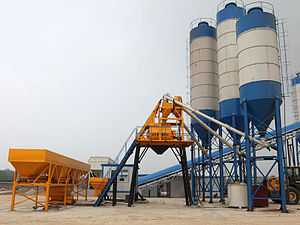Concrete plant



A concrete plant, also known as a batch plant, is a device that combines various ingredients to form concrete. Some of these inputs include sand, water, aggregate (rocks, gravel, etc.), fly ash, potash, and cement. There are two types of concrete plants: ready mix plants and central mix plants. A concrete plant can have a variety of parts and accessories, including but not limited to: mixers (either tilt-up or horizontal or in some cases both), cement batchers, aggregate batchers, conveyors, radial stackers, aggregate bins, cement bins, heaters, chillers, cement silos, batch plant controls, and dust collectors (to minimize environmental pollution).
The center of the concrete batching plant is the mixer. There are three types of mixer: Tilt, pan, and twin shaft mixer. The twin shaft mixer can ensure an even mixture of concrete and large output, while the tilt mixer offers a consistent mix with much less maintenance labor and cost.
Types
A ready mix plant combines all ingredients except for water at the concrete plant. This mixture is then discharged into a ready mix truck (also known as a concrete transport truck). Water is then added to the mix in the truck and mixed during transport to the job site.[1]
A central mix plant combines some or all of the above ingredients (including water) at a central location. The final product is then transported to the job site. Central mix plants differ from ready mix plants in that they offer the end user a much more consistent product, since all the ingredient mixing is done in a central location and is computer-assisted to ensure uniformity of product. A temporary batch plant can be constructed on a large job site. A concrete plant becomes central mix with the addition of a concrete mixer.[1]
Application
Concrete batching plants are widely used to produce various kinds of concrete including quaking concrete and hard concrete, suitable for large or medium scale building works, road and bridge works and precast concrete plants, etc.
More recently is the availability of the mobile concrete batch plant. This innovative device was designed for the production of all types of concrete, mixed cements, cold regenerations and inertizations of materials mixed with resin additives. The design includes multiple containers that separately transport all the elements necessary for the production of concrete, or any other mixture, at the specific job site. In this way, the operator can produce exactly what he wants, where he wants and in the quantity he wants through the use of an on-board computer. Once production is started, the various components enter the mixer in the required doses and the finished mixed product comes out continuously ready for final use. It is also suitable for the recovery of materials destined for landfill disposal, such as cement mixtures regenerated from masonry rubble. The mobile batching plant is easy to transport. It can be fixed-mounted on a truck, mounted on a truck with tipping box or mounted on an interchangeable cradle.
Automation and controls
Modern concrete batch plants (both ready mix and central mix,) employ computer aided control to assist in fast, accurate measurement of input constituents or ingredients, as well as tie together the various parts and accessories for coordinated and safe operation. With concrete performance so dependent on accurate water measurement, systems will often use moisture probes to measure the amount of water that is part of the aggregate (sand and rock) material while it is being weighed, and then automatically compensate the mix design water target.
Concrete Plant Manufacturers Bureau
A non-profit association brings together all of the main concrete plant manufacturers on common matters related to the industry. According to the CPMB's website, "The National Ready Mixed Concrete Association (NRMCA) endorses the members of the Concrete Plant Manufacturers Bureau as the preferred providers of concrete plants and associated equipment as providing quality equipment conforming to the standards and specifications of NRMCA’s plant certification program and the concrete plant manufacturers standards." "The primary function of the CPMB is to establish minimum standards for rating various components of concrete plants for the protection and assurance to the user that the plated components of the plants conform to these Standards."http://www.cpmb.org/about_CPMB.htm
References
- ↑ 1.0 1.1 "Concrete Batch Plant Modeling Guide". Iowa Department of Natural Resources. Retrieved 3 October 2012.
| Wikimedia Commons has media related to Concrete plants. |
Special Features of Concrete Plant
| |||||||||||||||||||||||